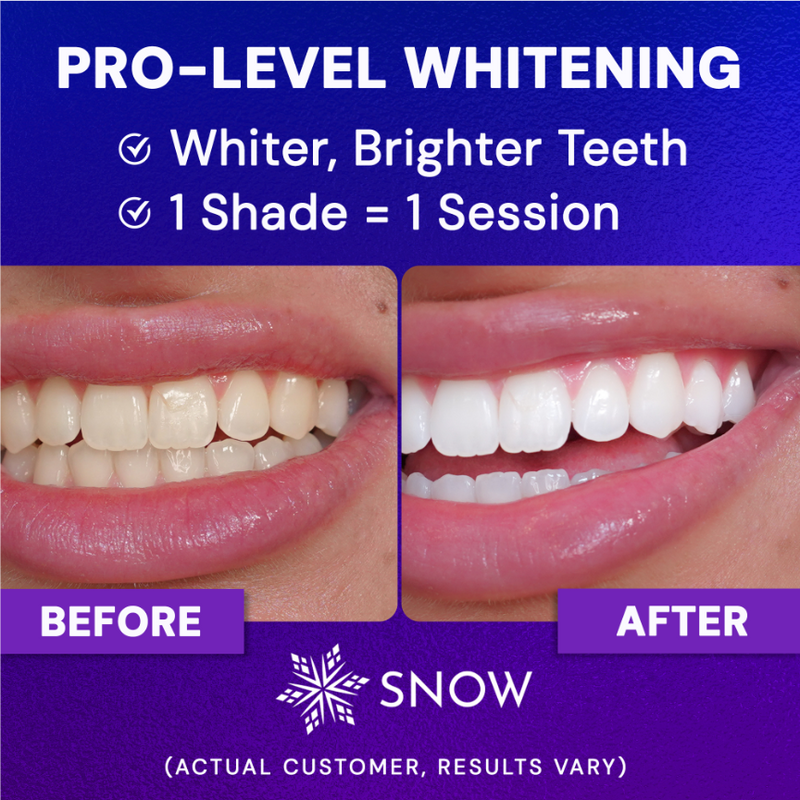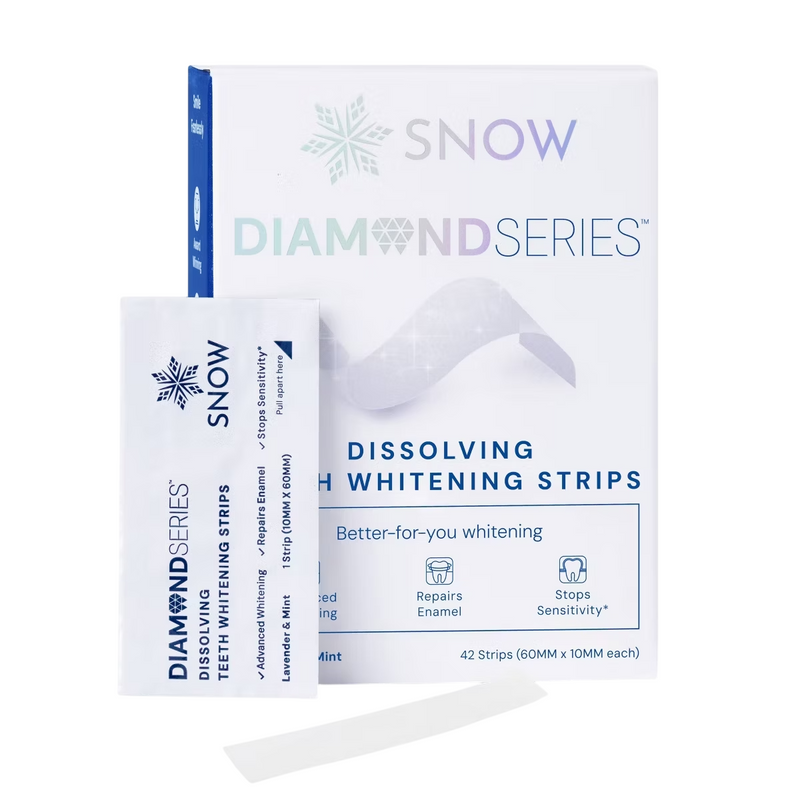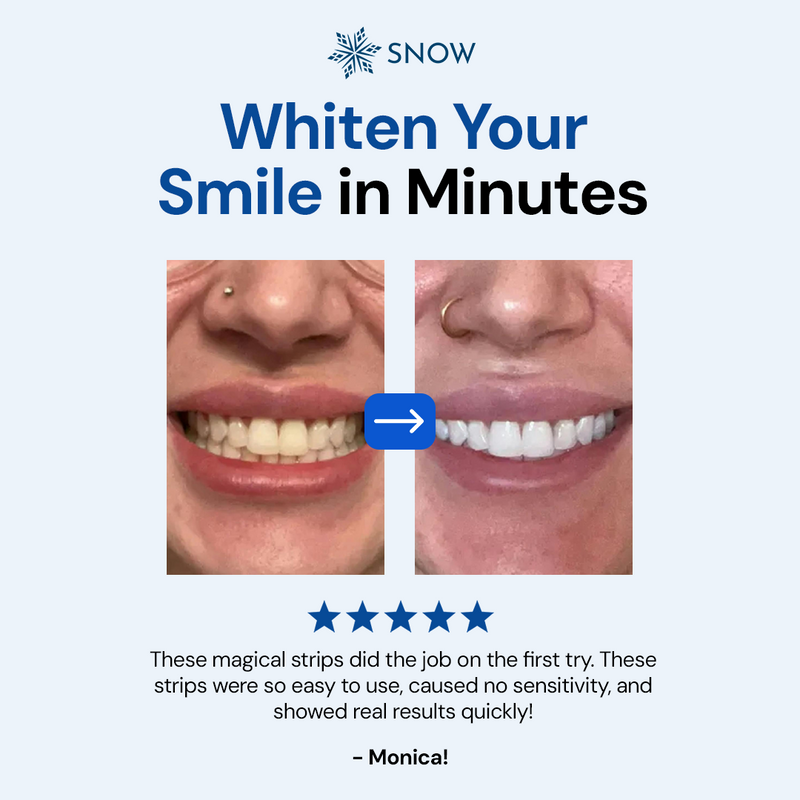Knowing how to treat burned lips from teeth whitening involves immediate and effective steps to alleviate discomfort and promote healing.
Burns from teeth whitening, typically caused by hydrogen peroxide or carbamide peroxide, can be treated at home and usually heal within 2-3 days. It's not uncommon for some individuals to notice their teeth yellow after whitening either, but this is usually a temporary effect as the teeth rehydrate.
Key treatments include applying cold compresses, using gentle cleaning methods, and avoiding acidic foods that can exacerbate irritation.
Additionally, applying Vitamin E oil can soothe and heal the affected area.
Our aim today at SNOW is to provide detailed guidance on each step to ensure quick recovery and prevent further irritation. For those planning to have white teeth for wedding season, it's advisable to start the whitening process well before teeth whitening on the big day to allow time for any potential sensitivity to subside.
What this article covers:
- Can You Get a Chemical Burn From Teeth Whitening?
- Is Teeth Whitening at Home Safe for Your Lips?
- How Do You Treat Burned Lips After Teeth Whitening?
Can You Get a Chemical Burn From Teeth Whitening?
Yes, chemical burns from teeth whitening are a real possibility, especially when using products containing hydrogen peroxide or carbamide peroxide. These active ingredients, while effective in whitening teeth, can sometimes cause irritation or a burning sensation on the gums.
This reaction is akin to a chemical burn, similar to a sunburn, where the affected area might become sore, turn white, and eventually flake off. After undergoing a procedure like teeth whitening after deep cleaning, it's crucial to follow the dos and don'ts after teeth whitening to ensure optimal results and minimize discomfort.
However, it's important to note that these symptoms are usually temporary and resolve within 24 hours.
At SNOW, we understand the importance of safe and effective teeth whitening. Our Teeth Whitening Kit, Teeth Whitening Strips, and Teeth Whitening Toothpaste are designed with your safety in mind. We ensure that our products contain ingredients that are effective yet gentle on your gums and teeth.
To prevent chemical burns, it's crucial to use these products as directed and consider options like custom-fit trays for an even application, minimizing the risk of irritation.
What Causes Burned Gums From Teeth Whitening?
The primary cause of burned gums from teeth whitening is exposure to the bleaching agents like hydrogen peroxide. While these agents are safe in the concentrations used in teeth whitening products, direct contact with gums can lead to sensitivity or pain.
This is why at SNOW, we emphasize the importance of following instructions carefully when using our teeth whitening range. We design our products to minimize gum contact and provide clear guidelines to ensure a safe and pleasant whitening experience.
In addition to using products correctly, it's also recommended to reduce acidic food and drink intake during the whitening process, as these can amplify gum sensitivity and irritation.
Using a specialized mouthwash for stained teeth can also be beneficial; learn how to reduce mouthwash burning sensation safely.
If you experience any discomfort, simple home remedies like rinsing with warm saltwater or applying cold compresses can provide relief. For persistent or severe irritation, it's advisable to consult a dental professional.
At SNOW, we're committed to providing you with not only effective whitening solutions but also the knowledge and support to use them safely and comfortably.
Is Teeth Whitening at Home Safe for Your Lips?
At SNOW, we prioritize your oral health and safety, especially when it comes to teeth whitening at home. The good news is, with proper use, teeth whitening at home is generally safe for your lips.

Our products, like the Arctic Frost Teeth Whitening Mouthwash, Lip Exfoliator, and Lip Applicator, are designed to ensure that the whitening process is not only effective but also gentle on your oral tissues.
The key to safe teeth whitening lies in the ingredients and their application. Products containing hydrogen peroxide or carbamide peroxide, known for their whitening efficacy, can be safely used at home.
These ingredients work by breaking down discoloration-causing molecules on your teeth, resulting in a brighter smile.
However, it's crucial to keep these substances off your gums and lips to avoid sensitivity and irritation. After whitening teeth, it's important to follow proper oral care routines to rehydrate teeth after whitening. Following product instructions meticulously is essential for a safe whitening experience.
According to the Cleveland Clinic, the American Dental Association (ADA) has deemed hydrogen peroxide whiteners safe and effective. This endorsement underlines the importance of choosing products that meet dental standards.
At SNOW, our products align with these guidelines, ensuring that you can achieve a brighter smile without compromising your oral health.
In addition to using the right products, consulting with a dentist for personalized advice is always recommended. They can guide you on the best practices suited to your individual needs, ensuring that your teeth whitening journey at home is both effective and safe.
Remember, while teeth whitening can significantly enhance your smile, it should always be done with care and consideration for your overall oral health.
How Do You Treat Burned Lips After Teeth Whitening?
Treating burned lips after teeth whitening is a crucial step in ensuring a safe and comfortable whitening experience. At SNOW, we recommend a few effective methods to manage and heal burned lips:
- Cooling Compresses: Applying cool, clean water or a damp cloth to the affected area is the first step. This helps in reducing inflammation and soothing the burn. It's important to use room-temperature water and ensure that the cloth is clean to prevent any further irritation.
- Cleaning: Gently cleaning the area with soft soap or saline solution is recommended. This helps in keeping the burn clean and aids in preventing infection.
- Aloe Vera: Known for its soothing properties, aloe vera is an excellent natural remedy for treating burns. Healthline states that the inner gel of the aloe vera leaf can help soothe the pain and inflammation of burns, accelerating the healing process. It also helps in moisturizing the area, preventing dryness and cracking.
- Topical Antibiotic Ointments: After the initial phase of healing, using topical antibiotic ointments can help prevent infection. Products like Neosporin or Polysporin are good over-the-counter options, but they should be used only if there is no allergy to these ingredients.
- OTC Pain Relievers: Over-the-counter pain relievers can be used to manage pain associated with the burn. They provide relief and make the healing process more comfortable.
In cases where the burn is more severe, showing signs of infection or not improving, it's crucial to seek medical attention. For sunburned lips, aloe vera gel and cool compresses are effective until the skin heals. Incorporating vitamins for whiter teeth into your diet can also complement your whitening regimen.
In the case of chemical burns, which are more common with teeth whitening, the treatment approach is similar to that of thermal burns.

Conclusion
Achieving a brighter set of teeth at home can be a safe and effective process when done correctly. From understanding the potential for chemical burns during teeth whitening to learning how to treat them, this guide has covered essential aspects of at-home teeth whitening safety.
Remember, products like strips, gels, and mouthwashes are effective tools, but their application requires care to avoid gum irritation and lip burns.
For those looking to enhance their teeth's appearance with DIY teeth whitening solutions, explore SNOW's range of products that are designed for safety and efficacy.
If you liked this article, check out these related titles:
- Do Teeth Continue to Whiten After Treatment
- Can You Wear Retainers After Teeth Whitening
- Benefits of Teeth Whitening
- Teeth Whitening Facts
- Teeth Whitening Steps
- Teeth Whitening Secret
- Does Gum Make Your Teeth Yellow?
- Foods That Make Your Teeth Yellow
- Why Do Teeth Yellow with Age?
- Does Coke Make Your Teeth Yellow?
- Do Retainers Make Your Teeth Yellow?
- How Long After Teeth Whitening Can I Drink Alcohol?
- How to Keep Teeth White While Drinking Coffee
- How Long After Home Teeth Whitening Can I Drink Tea?
- Does Stannous Fluoride Stain Teeth?





































































